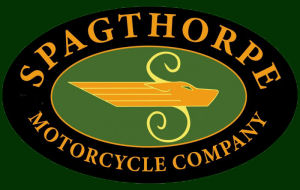I was poring over
the Spagthorpe Archives when I came across a curious item, a reference
to a Spagthorpe Newfoundland in a 1964 issue of Road & Driver Magazine.
Entitled "British Invasion," the article described a curious
contraption which sported an unusual combination of four wheels, chain-drive,
tandem seating, and a steering yoke. The photographs were of something
vaguely motorcycle-like, something that might be the brain-child of corporate-executive
designers of the American Motor Company.
Curious, I continued
my research, hoping to find some mention of this mysterious model in publications
more relevant to this subject. But, as expected, this Spagthorpe received
the usual level of coverage by the motorcycle press: it was ignored completely.
The reasons for this apparently deliberate selective blindness to products
of the Spagthorpe Motorcycle Company are manifold, but in this case might,
it pains me to say it, be perfectly justified.
The Spagthorpe Newfoundland
is a four-wheeled motorcycle. At first glance, this may appear to be a
contradiction in terms, but when one considers the unusual suspension
layout—dual interlinked symmetrical single-sided swingarms in the
back and dual interlinked hub-steering springer front axles—ones
initial confusion is confirmed.
The rear drive is,
in typical Spagthorpe fashion, overengineered. Where the usual shaft drive
employs a spur gear on the shaft and a crown gear for the wheel, the Newfoundland's
final drive's crown gear drives a curious set of gears, termed "planetary"
by the engineers, which drive the two short axle shafts. The reason for
this, according to the literature, has something to do with differential
rotation of the left and right drive wheels, an altogether curious concept
which I in all my years as a motorcycle engineer have never encountered.
Why the engineers didn’t employ the obviously simpler design of one
spur gear and two crown gears—a design which would be elegant in
its simplicity and light weight—is beyond me.
The transmission
is a delight to behold. Because of the engine's prodigious output,
the transmission designers were challenged to find an elegant, simple,
and reliable solution that would survive in this high-torque environment.
It would be fair to say that in this heroic endeavor the designers failed
completely. The transmission sports paired primary, secondary, and tertiary
shafts, each with identical gears, cogs, synchronizers, splines, ferrules,
mesh-plates, dogs, forks, shift shafts, linkages, and selector barrels.
Apparently the original intent was to send power to two drive shafts,
but because of a last-minute design change, promped perhaps by the realization
that one of the shafts would be rotating in the wrong direciton, a single
output shaft was used instead. At the same time, the concept of dual shift
levers was dropped in favor of a more traditional two down, one up, one-to-the-right,
two up, one back, three down and one over shifter on the right side.
The clutch is a multiplate
semi-wet design lubricated at intervals by finely engineered spiderlike
passages in the engine and transmission oil seals.
Where the transmission's
complexity evokes the sort of delight normally reserved for tourists gaping
in wonder at the giant clockwork mechanism of the clock in Spaten-Partenkirchen's
Town Hall, the engine elicits gasps of a sort usually heard only from
the audience of a movie starring Vincent Price or Peter Cushing. The engine
is a derivative of the Mastiff's 16-litre
W-10. This, however, was a proper W-14. Sporting eight 1300cc pistons
in an octopposed configuration and six 1800cc pistons in a 60° V-6
with a common crankshaft, the engine's 21,200cc displacement eclipsed
anything seen on any wheeled vehicles until the giant Caterpillar strip-mining
dump trucks legalized during the environmentally-conscious Reagan years.
The engine's sound was an awesome roar the likes of which were not
to be heard again until the release of the cinematic blockbuster Earthquake—and
then only by people who had not heard the original.
Initial designs called
for water-cooling, but the requisite fifty gallon cooling system was deemed
cost-prohibitive.
The massive yet teardop-shaped
fuel tank, lovingly evocative of the classic choppers beloved of Colonials
during the ’50s, has capacity of ten gallons. Surprisingly, even
when filled to the brim, it hardly affects the motorcycle's balance
or steering. In fact, the difference in handling made by the presence
or absence of sixty pounds of fuel—not to mention three hundred additional
pounds contributed by passenger and fully loaded touring bags—is
so slight as to be unnoticeable.
Steering is by either
a direct remote mechanical linkage or by an optional hydraulic drive,
a feature to be revived in later years in certain forms of industrial
machinery. In either case, it is actuated by a yoke, not a wheel, and
there is a lever in the dashboard which, anticipating a simlar feature
of the Pit Bull, reverses the direction of
the steering sense. The two modes were lovingly termed by the Spagthorpe
engineers as "Normal" and "Idiot."
The Newfoundland
is an obscure Spagthorpe design, and some may say deservedly so. The degree
to which it was accepted and made successful by the motorcycling community
of the ’60s, such as it was, may lead us to wonder why its modern
descendant, the Daimler-Chrysler
Tomahawk, is receiving so much fawning attention from the automotive
press. Perhaps its kinship with the earlier Spagthorpe—whether it
is purely by unlucky coincidence or, dare we say, a deliberate rehash
of an old and deservedly forgotten concept—explains why its reception
in the modern motorcycle community is most succinctly summed up in one
word: "Hunh?"

